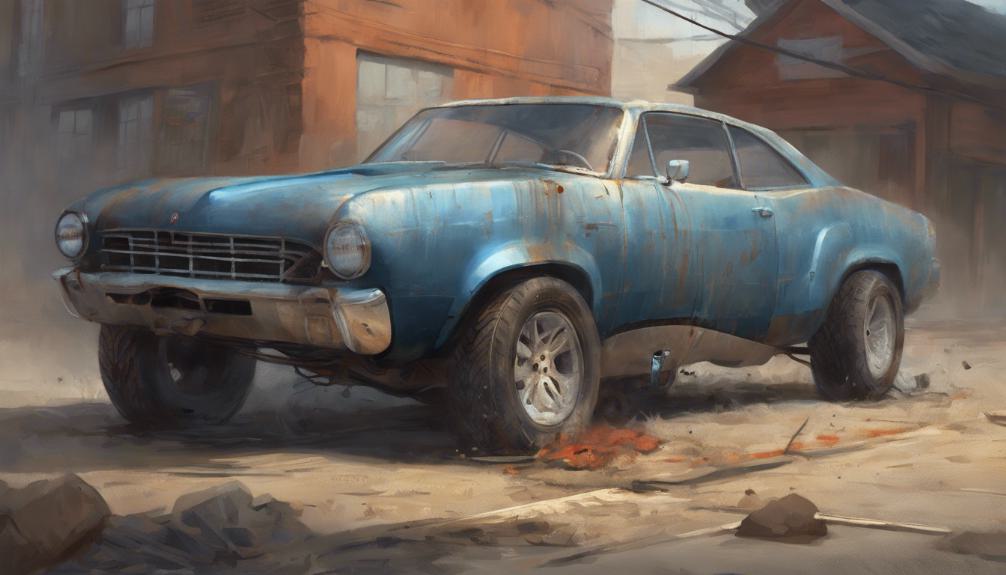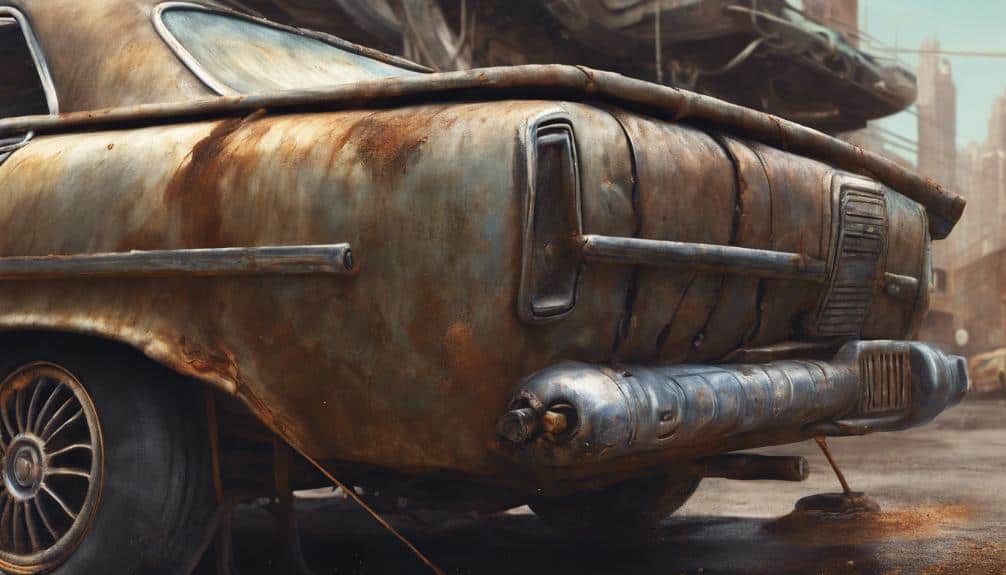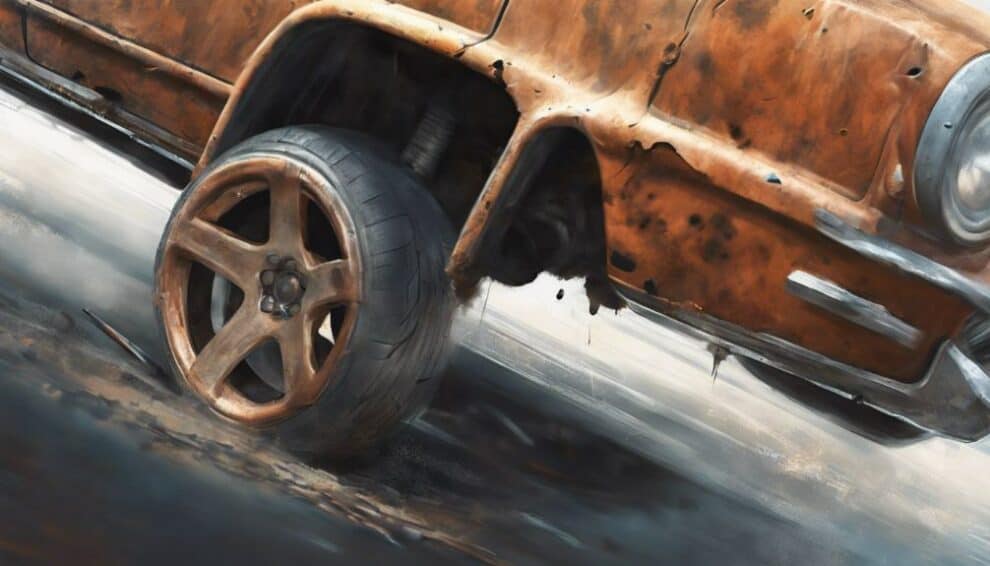If you hear high-pitched squeaks while turning or struggle with steering, you might have tie rod wear. It affects how well your steering responds and can mess up your alignment.
Look for cracks, grease leaks, or rusty spots. Listen for metal scraping sounds or knocking noises. DIY check by lifting your car and inspecting tie rod ends for wear.
Address issues promptly for safety. Swift tie rod replacement is important for safe steering and avoiding accidents. Want to uncover more about spotting and dealing with tie rod issues?
Key Points
- Listen for knocking or clunking noises while turning.
- Lift the front of the vehicle to check for play in tie rods.
- Inspect tie rod ends for visible wear signs.
- Shake front tires to detect abnormal movement.
- Address detected issues promptly for safety.
Common Symptoms of Tie Rod Wear

If you notice a knocking sound when you turn or hit bumps, it could be a common symptom of tie rod wear.
This issue can impact your steering responsiveness, causing it to feel loose or imprecise.
When tie rods are worn, you may also experience alignment issues, where your vehicle veers to one side even when the steering wheel is straight.
Difficulty in steering, especially during sharp turns, is another indication of potential tie rod problems.
These issues can affect your overall driving experience and safety on the road. If left unaddressed, tie rod wear can lead to more severe problems such as clunking or grinding noises while turning, signifying excessive wear on tie rod ends.
It’s important to pay attention to these early warning signs and have your tie rods inspected and replaced if necessary to ensure your vehicle’s top performance and your safety while driving.
Visual Indicators of Tie Rod Issues
To identify potential tie rod issues, visually inspect the protective boots for cracks or tears, check for grease leakage or corrosion, and examine the ends for any visible damage.
Performing regular visual inspection techniques is important for tie rod maintenance. Recognizing warning signs early on can help prevent more severe problems down the road.
Look out for abnormalities like rusting or discoloration on the tie rod ends, as these could indicate potential wear and tear.
Also, pay close attention to the overall condition of the tie rod ends for signs of deterioration, such as loose or wobbly parts.
Audible Signs of Tie Rod Problems

When driving, listen for high-pitched squeaking noises during turns as they can indicate potential tie rod problems. These sounds may suggest issues with the ball and socket of the tie rod ends, signaling wear and tear.
If you hear metal scraping noises coming from the tie rod ends, it could be a sign of lack of lubrication or damaged rubber boots.
Then, loose tie rod ends can lead to a bumpy ride, especially on uneven road surfaces.
Keep an ear out for any odd sounds emanating from your steering system as they can be a warning sign of impending problems.
Apart from squeaks and scrapes, pay attention to any steering vibrations or suspension noises, as these can also point to tie rod issues.
Regularly checking for and addressing these audible signs of wear can help prevent further damage and ensure a safer driving experience.
Could a Whistling Sound in My Car be a Sign of Tie Rod Troubles?
If you hear a whistling sound coming from your car, it could be a sign of tie rod troubles. One of the common causes of car whistling is a damaged tie rod, which can affect your steering and overall vehicle safety. It’s important to have this issue checked by a professional mechanic.
Are the Signs of Wear for Tie Rod Troubles Similar to Symptoms of a Bad Fan Clutch?
Yes, the warning signs of bad fan clutch and tie rod troubles are not similar. The signs of a bad fan clutch include overheating, loud engine noise, and poor air conditioning performance. On the other hand, the signs of tie rod troubles include uneven tire wear, shaky steering wheel, and a knocking sound while turning.
DIY Inspection for Tie Rod Wear
Listening for any unusual noises like knocking or clunking while turning can help you detect potential tie rod wear during a DIY inspection. If you hear any suspicious sounds while turning, it could indicate tie rod problems.
When checking for tie rod maintenance issues, start by lifting the front of your vehicle to look for excessive play in the tie rods and tires.
Inspect the tie rod ends for visible signs of wear such as cracks, tears, or grease leakage. Conduct a basic inspection by shaking the front tires side to side and up and down to detect any abnormal movement.
It’s crucial to address these issues promptly to guarantee your safety on the road.
While these DIY repairs can help you identify potential tie rod wear, always consult a professional mechanic for an accurate diagnosis and repair recommendations.
Regular inspections and timely maintenance can prevent more severe problems down the road.
Importance of Prompt Tie Rod Replacement

Replacing tie rods promptly is essential for maintaining safe vehicle operation and ensuring steering control. Failing to address worn tie rods can lead to safety hazards and costly consequences.
When tie rods wear out, they can compromise your ability to steer properly, putting you and your passengers at risk of accidents.
Ignoring symptoms of tie rod wear, such as excessive play in the steering wheel or unusual noises when turning, can result in accidents and even cause premature wear on other steering components.
Prompt replacement of worn tie rods is vital to prevent these safety hazards and avoid expensive repairs down the line.
Make sure to have a qualified technician inspect your tie rods regularly to catch any issues early on. By staying proactive and addressing tie rod problems promptly, you can maintain safe and reliable steering in your vehicle.
As an Amazon Associate we earn from qualifying purchases.










